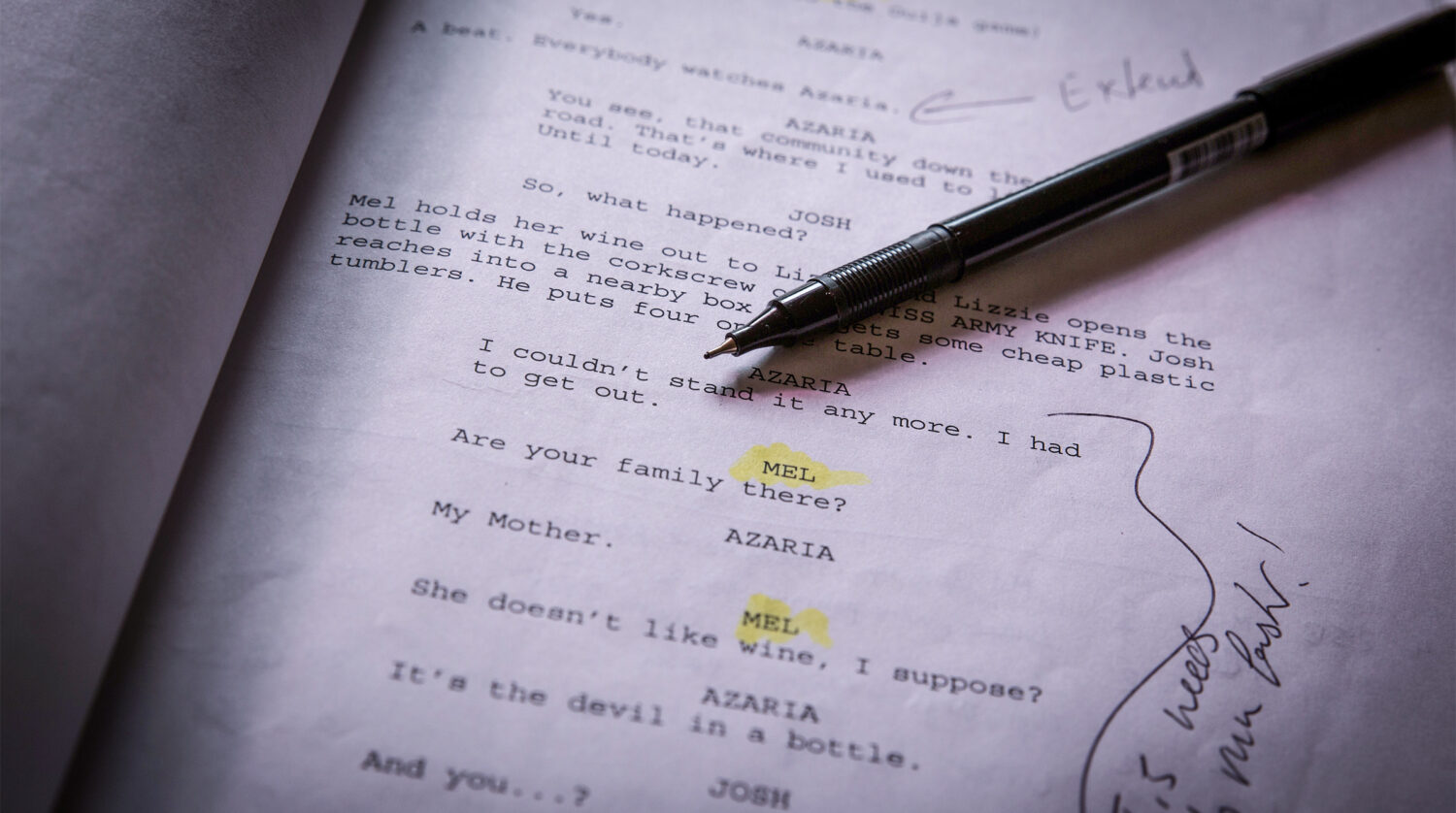Script writing
This step has a specific role in the pre-production, production, and post-production processes and requires particular writing skills that can be best achieved through a collaborative procedure in a 3D animation studio. In this article, we are going to take a look at the fundamentals of animation scriptwriting and Dream Farm’s 5 step procedure on the subject.
What is scriptwriting in animation?
The script is the formal, written, literary form of the story. Basic character movements, environments, time, actions, and dialogues are transcribed in the script. By looking at it, different pre-production and production teams can have a vivid understanding of the overall story and collect the necessary information to do their part quickly and precisely. The final script will be the reference structure for the next step of the production pipeline: Storyboarding.
Just like live-action, every major event taking place in a 3D animation must be transcribed in the script. This includes whatever the audience of a 3D animation is going to see and hear in detail; such as dialogues, sound effects, music scores, fades, transitions, descriptions, etc.
A script consists of 3 main elements:
- Location
- Action
- Dialogue
Why an animation script is essential?
Writing the script for a 3D animation is in fact the first opportunity to express the storyline and plot accurately. Scriptwriting for a 3D animation is a repetitive procedure and might take numerous revisions. Transferring thoughts onto paper is the hardest task in the process.
However, writing a script early on helps 3D animation studios with the following:
- Keep everyone on the same page
- Fix potential holes in the story
- Further character development
- Correct bad pacing of events
- Better storyboarding
Key differences between writing for animation and live-action
1. Descriptions
In live-action, most of what’s happening on the screen does not require much description or further details are up to the director to decide. But 3D animation is a different story. It’s a very unique visual medium in which a huge part of what’s going on is about things we’ve never seen before and needs to be visualized in detail.
Most storyboard artists translate only the written words into visual images. Therefore if something is not precisely described in the script, it won’t make it to the screen. In general, effective communication of the ideas and visual elements of a 3D animation requires more description with much more details compared to live-action.
2. Length of the script
Detailed descriptions in 3D animation lead to another key difference between live-action and animation scriptwriting: Length.
The general rule for live-action scriptwriting is “one minute of screen time per page”. This format is fairly standard among film industries. For example, a 90-minute live-action screen time would be about 90 pages of script.
But in animation it’s not the case: one minute of screen time is approximately equal to one and a half pages of animation script. So a 90 minute 3D animation script would be about 135 pages.
How to write an animation script in 5 simple steps
The process is quite straightforward and of course similar to writing a screenplay for live-action: You come up with an idea, describe the story with a three-part structure including a beginning, middle, and end. The next stage is writing the script, laying out each scene, including actions and gags with full scene description and dialogues.
Here at Dream Farm Studios, we use the following procedure to write a script for a 3D animation based on a story that works:
1. The logline
We start by summarizing the plot as a logline; the DNA of the animation story. A logline is a short summary of the main events in the story, usually no more than one sentence. In other words, a logline is a single sentence describing your entire story (sounds challenging, right?).
Descriptive language helps clarify the logline so everyone can identify the main idea of the story as well as its central conflict. A logline gives the reader emotional insight into the story as a whole.
It is said that the logline was printed on the spine of a screenplay back in the old days so that the producers could get a quick understanding of the story to decide on reading the script or not. It serves the same purpose today, although communicated verbally most often, or included in treatment.
2. The premise
The title, the logline, the main characters, and a concise description highlighting the main turning points of the story constitute the premise. A premise must contain the beginning, middle, and ending of the story with enough detail to fully convey the idea.
Writing a premise also provides a unique opportunity to view the story as a whole and identify potential strengths and weak points of the story for further development.
3. Script outline
After coming up with the logline and premise, it’s time to break down the whole story to its narrative-arc components and write every scene beat by beat. Scriptwriters usually use notes or index cards for this matter: a card for each scene, with a checklist of the story beats and notes about the characters or plot on each card. There are a number of screenwriting software as well that do the work.
The overall goal is to plot out the story from the beginning to the end. In order to prevent time wastes down the road, it’s better to write down as much detail as possible. It is important to keep an eye on the essence of dialogues, emotional beats, and finally how certain events lead into one another at this stage.
4. The first draft
Setting a deadline is crucial to writing the first draft of the script. The management team of the animation studio should keep an eye on deadlines and hold the creative team accountable for working on the script.
Determined to write a certain number of pages per day, the scriptwriters follow along with the outline and put their ideas on paper. The main goal at this stage is to script down every single shot of the animation; it’s more like storyboarding with words. An animation scriptwriter must be able to clearly visualize the script as the final animation.
One of the important tasks during this phase is writing the dialogues if there are any. The scriptwriters usually read out loud and even act out the dialogues they write to see if they sound natural and specific to each character. The dialogues must also have a natural flow and sound clear. Any problems in the dialogues or other features of the script will most often be documented and dealt with later in the following revisions.
5. Revision
Taking a short break before revising the first draft of the 3D animation, is usually a good idea. Focusing on other projects and coming back to the draft with a fresh mind, helps identify possible weak points easier. Confusions in the story or actions without moving the story forward are some of the weak points the scriptwriters must look for during further revisions.
The writers usually keep rewriting the script until they’re happy with it; working from larger problems to minor problems. The more they polish the final script, the easier the rest of the production pipeline would be; as long as the project timeline is not violated.
Format of a standard script for 3D animation
Scriptwriting for 3D animation is almost identical to live-action in terms of the format. There are lots of software in the market that helps scriptwriters focus on the content instead of the format. However, knowing the right format and staying loyal to it is essential. Poorly formatted scripts look unprofessional and hard to understand.
Location formatting
The location and daytime of each scene are called the slugline and should be included at the beginning of a scene in ALL CAPS with “INT” for the interior and “EXT” for the exterior.
Example:
INT. SCHOOL. DAY
Action formatting
The action that precedes or follows a dialogue is described here.
Example:
INT. SCHOOL. DAY
AMY sits on her chair and looks at the ceiling; lost in thought.
Dialogue formatting
The name of the character would be written in ALL CAPS indented in the center of the page and the dialogue lines will be written below it; indented again.
Example:
INT. SCHOOL. DAY
AMY sits on the chair and looks at the ceiling.
MARY
(Looking at AMY curiously)
What are you looking at?
AMY
(Looking back at Mary in surprise)
How could you not see it?
Audio Recording
With the final script being written and agreed upon, the production team will have the opportunity to start recording the final character dialogues, narrations, background or ambient sounds, music, and other sound effects. The recorded material will be used for timing and syncing purposes in the animatic, animation, and compositing stages of the pipeline.
Recording an initial rough draft and replacing it with the final version down the pipeline is also another option; although it’s not really recommended as it can cause unnecessary complications.
Conclusion
Scriptwriting for 3D animation based on a well-thought idea and a well-crafted story can provide a comprehensive recipe for the animation production team throughout the rest of the animation production pipeline; especially the next step: Storyboarding.
Writing a script for a 3D animation is very similar to standard scriptwriting for any other medium. However, there are subtle differences that must be taken into consideration. This formal, written literary form of the story describes basic character movements, environments, time, actions, and dialogues. By looking at the script, the animation studio artists can have a vivid understanding of the story and collect the necessary information to do their part correctly.




It’s so educative
Thank you very much Ibrahim.